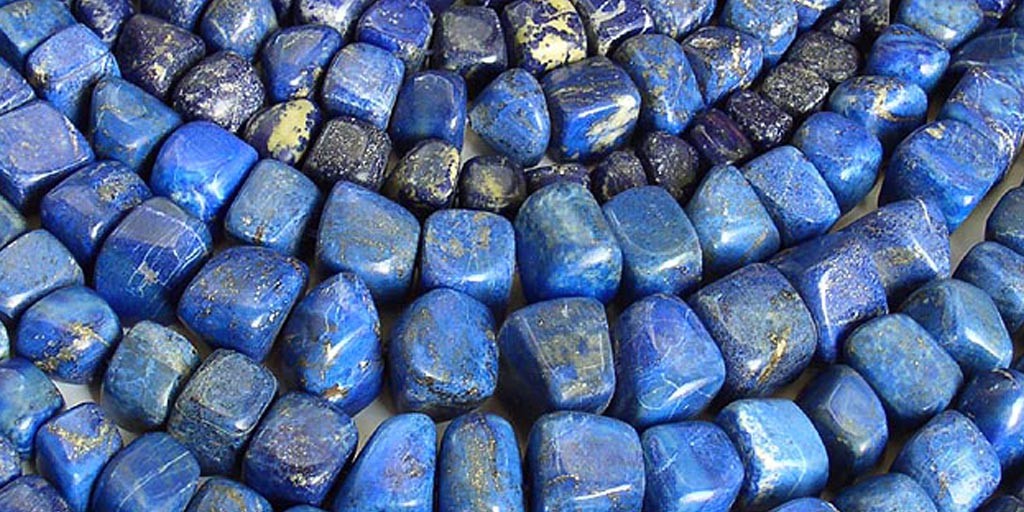
Lapis lazuli is an indigo blue semi-precious stone prized for its brilliant color and enhancement of intuitive insights. Notably, its name translates as “stone of blue.” And due to its deep blue-purple with gold flecks coloring, this crave-worthy stone has enjoyed popularity from ancient civilizations to the present.
Lapis lazuli’s reputation as the “stone of insight and intuition” stems from its stimulating effect on the 3rd Eye Chakra. For the 3rd Eye Chakra is responsible for our general intuition and more specifically receiving clairvoyant messages. And clairvoyance (clear seeing) enables us to see in our mind’s eye visual messages from our Spirit Guides and Angels.
Properties of Lapis lazuli
Moreover, as a metamorphic stone, Lapis is created from changes made to existing igneous stone formations within the Earth’s crust. For these initial stone formations experienced great heat and pressure underground causing their transformation into Lapis lazuli.
Furthermore, Lapis is a member of the Isometric crystal system and is opaque with a waxy luster. And its Mohs hardness of 5 to 5.5 makes it shapeable into objects of great beauty.
Notably, most of the Lapis on the market today comes from Afghanistan. But smaller amounts are also mined in Russia, Chili, and the U.S.
Difference in Lapis lazuli and Sodalite

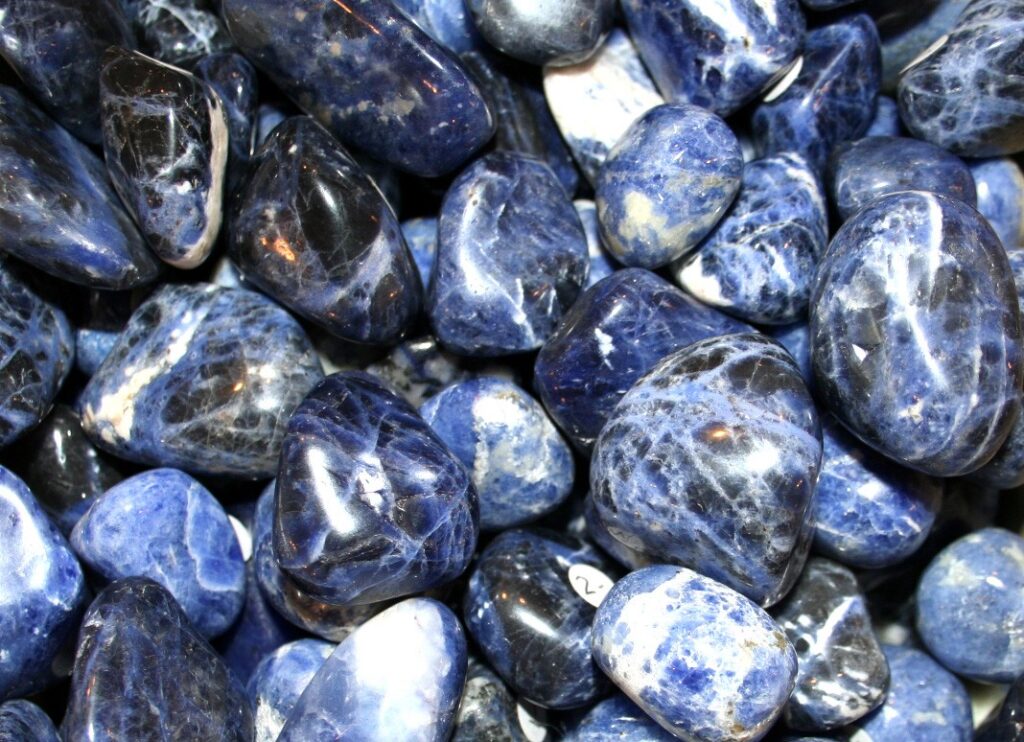
Lapis and Sodalite are two blue stones that have often been mistaken for the other. But there are some important differences between them as can be visually detected in the images above. Lapis lazuli is displayed on the left and Sodalite is displayed on the right.
Although, referred to as a crystal, Lapis is a rock. This means it’s made up of several minerals (crystals) rather than just a single mineral. Lapis specimens are mainly made of Lazurite, but may also contain varying degrees of Calcite, Sodalite and metallic Pyrite. And its Pyrite inclusions causes the gold flecks or veining in Lapis’ appearance.
However, Sodalite is mostly made of a mineral group known as Sodalite. Thus, it’s a true crystal. And its blue coloring is less purple, and it has more white and grey streaks than Lapis. But the real tell that a Sodalite specimen is not Lapis is the missing gold flecks or veining signature of Lapis.
History of Lapis lazuli
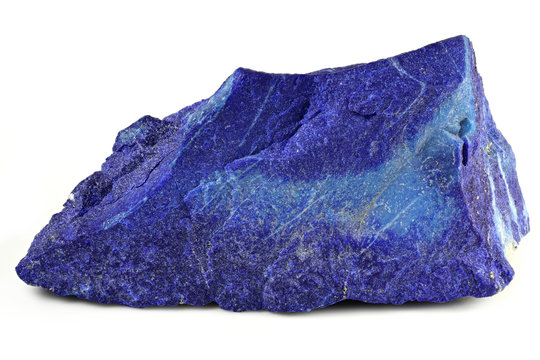
In its early history, Lapis was a symbol of prestige and coveted by royals and nobility. Its use goes back to the ancient civilizations of Mesopotamia and the Indus Valley in 7th century BC.
The oldest discovered Lapis artifacts were found among the ruins of the earliest Indus Valley civilization, Bhirrana dating to 7570 BC.
Lapis continued to be valued throughout history, as pieces were used in jewelry, and inlaid in burial relics in ancient Egypt. In fact, King Tutankhamun’s (1341-1323 BC) funeral mask was inlaid with Lapis. Additionally, Egyptian Queen Cleopatra used ground Lapis for her infamous blue eyeshadow.
Later, in the European Renaissance and Baroque periods, artists used paint pigment made from ground Lapis (ultramarine) in their masterpieces. Most notably, Michelangelo used ultramarine pigment in his infamous Sistine Chapel ceiling frescoes.
Where to Find Lapis lazuli
Today, Lapis is no longer just for the prestigious, as it’s marketed to the masses and attainable by most anyone. It’s not overly expensive and can be found in rock shops, new age stores, and on the internet.
However, quality dictates a Lapis specimen’s price. Generally, less whitish Calcite and greyish Sodalite and more gold Pyrite inclusions increase a specimen’s value and price. In fact, some Lapis pieces can have so much white and grey coloring you would swear it’s Sodalite.
Buyer Beware of Imitations
It’s sad, but due to the explosion in popularity of crystals in our current society, many stones are being faked. Highly sought after stones such as Lapis, Turquoise, and Moldavite are now being counterfeited in factories in China and elsewhere.
Note: the below types of imitation Lapis don’t refer to a coating sometimes applied to stones to stabilize and protect them.
Magnesite – is a stone that’s often been altered and passed off as natural Lapis. Magnesite is a whitish stone with yellowish veining. And due to not having any color of its own, it can be easily died indigo to resemble Lapis.
Howlite – is another whitish stone but with greyish veining. It has also been died Indigo to resemble Lapis. But without the gold flecks and veining it’s easier to spot as a fake than Magnesite.
Plastic/Resin/Epoxy Lapis lazuli – are imitation Lapis pieces 100% man-made in a mold with added indigo color. However, these fakes are easier to spot than the Magnesite and Howlite fakes. This is because they’re lighter in the hand than a natural stone and their veining will be only surface deep.
Reconstituted Lapis lazuli – is a resin matrix of tiny ground up pieces of natural Lapis to appear as a solid piece. This method is used in some Lapis inlaid pieces of jewelry. And then a resin coating is applied to stabilize and keep the ground pieces together.
Healing Effects of Lapis lazuli on the Mind-Body-Spirit
Mental/Emotional Effects of Lapis lazuli: Lapis has a stress relieving effect. And due to its stimulating effect on the 3rd Eye Chakra, it helps with learning disabilities and depressive thoughts.
Moreover, Lapis’ stimulating effect on the Throat Chakra helps with communication and expressing one’s truth and feelings.
Physical Effects of Lapis lazuli: Lapis lowers blood pressure and boosts the immune system. And due to its stimulating effect on the Throat Chakra, it’s helpful for sore throat, hoarseness, laryngitis, and thyroid issues.
Additionally, Lapis helps with hearing issues, vertigo, and insomnia.
Spiritual Effects of Lapis lazuli: Lapis’ stimulating effect on the 3rd Eye Chakra protects against psychic attack and enhances intuitive abilities. Thus, it facilitates receiving spiritual guidance.
Using Lapis lazuli
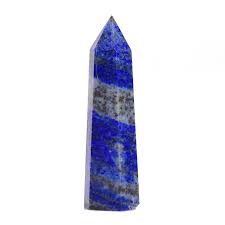
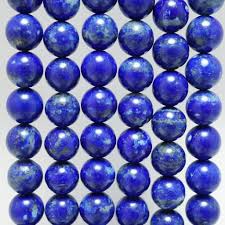
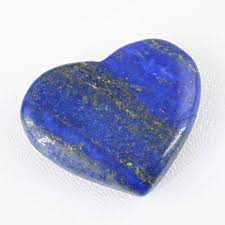
Jewelry – Lapis has been fashioned into jewelry ever since its ancient discovery. It lends well to pendants, earrings, bracelets, and rings set in silver or gold.
Additionally, Lapis beads are made into necklaces and bracelets. And due to direct contact with the skin, Lapis bead jewelry will have a stronger healing effect on the wearer.
Moreover, Lapis is especially beautiful when combined with Turquoise and Coral in American Indian themed Jewelry pieces.
Meditation – Since Lapis stimulates the 3rd Eye it enhances clairvoyant messages and guidance received in meditation.
Dreamwork – Due to its eliminating effect on insomnia, Lapis facilitates dreamwork. Moreover, it stimulates the 3rd Eye’s mechanism for dreaming and visualization.
Healing – Lapis has healing effects on issues related to the Throat and 3rd Eye Chakras as mentioned above.
Decor – Lapis is made into many beautiful decorative objects for the home and alter. These include such items as obelisks, crystal balls, hearts, animals, and spiritual deities. And I happen to own specimens of all of these Lapis objects. Lol!
Final Words for Lapis lazuli – Stone of Insight and Intuition
Lapis lazuli is truly a stunning stone with many healing benefits for mind, body, and spirit. The most notable of its benefits is its strong effect on the 3rd Eye’s insight and intuition, especially clairvoyance. And who doesn’t want increased intuition? Nobody, that’s who. Lol!
Personally, I often wear Lapis for its Indigo color, one of my fav colors. And I use it in crystal grids and Reiki sessions for its effect on the Throat and 3rd Eye Chakras.
I hope you will consider adding a beautiful Lapis lazuli specimen to your crystal or jewelry collection. I know you will cherish it!
FYI: If you are interested in becoming a certified Crystal Therapist see my Crystal Therapist Certification Home Study Course on my energy healing school website Reiki Essence Institute.
Leave a Reply